The AMD A8-7650K APU Review, Also New Testing Methodology
by Ian Cutress on May 12, 2015 10:00 AM ESTGaming Benchmarks: Mid-Range
Alien: Isolation
If first person survival mixed with horror is your sort of thing, then Alien: Isolation, based off of the Alien franchise, should be an interesting title. Developed by The Creative Assembly and released in October 2014, Alien: Isolation has won numerous awards from Game Of The Year to several top 10s/25s and Best Horror titles, ratcheting up over a million sales by February 2015. Alien: Isolation uses a custom built engine which includes dynamic sound effects and should be fully multi-core enabled.
For low end graphics, we test at 720p with Ultra settings, whereas for mid and high range graphics we bump this up to 1080p, taking the average frame rate as our marker with a scripted version of the built-in benchmark.
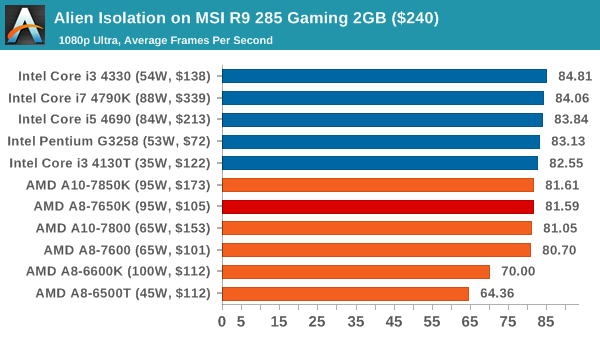
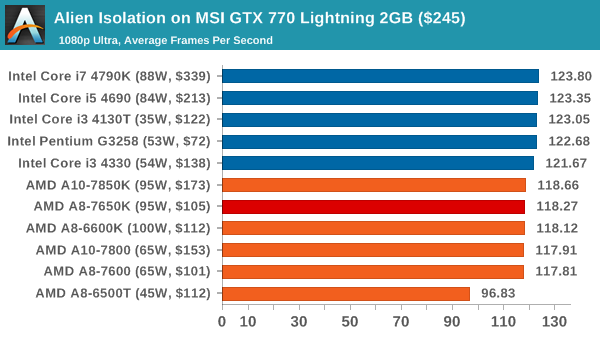
For mid range cards, Alien Isolation has a direct split for Intel and AMD, but the difference is a few FPS at best. It would seem that cores matter not here.
Total War: Attila
The Total War franchise moves on to Attila, another The Creative Assembly development, and is a stand-alone strategy title set in 395AD where the main story line lets the gamer take control of the leader of the Huns in order to conquer parts of the world. Graphically the game can render hundreds/thousands of units on screen at once, all with their individual actions and can put some of the big cards to task.
For low end graphics, we test at 720p with performance settings, recording the average frame rate. With mid and high range graphics, we test at 1080p with the quality setting. In both circumstances, unlimited video memory is enabled and the in-game scripted benchmark is used.
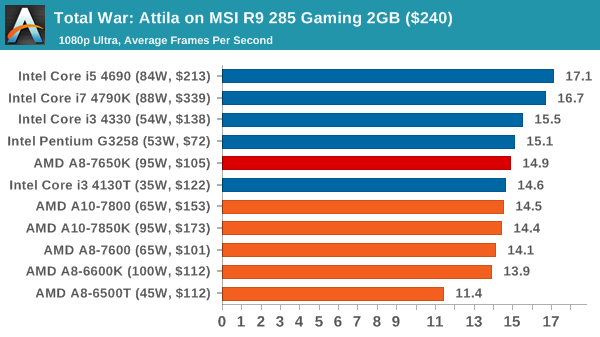
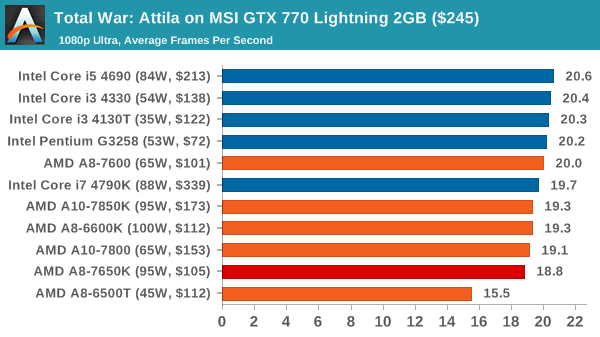
Neither combination here pulls Attila into a reasonable gaming rate, although there are bigger differences using the R9 285 GPU.
Grand Theft Auto V
The highly anticipated iteration of the Grand Theft Auto franchise finally hit the shelves on April 14th 2015, with both AMD and NVIDIA in tow to help optimize the title. GTA doesn’t provide graphical presets, but opens up the options to users and extends the boundaries by pushing even the hardest systems to the limit using Rockstar’s Advanced Game Engine. Whether the user is flying high in the mountains with long draw distances or dealing with assorted trash in the city, when cranked up to maximum it creates stunning visuals but hard work for both the CPU and the GPU.
For our test we have scripted a version of the in-game benchmark, relying only on the final part which combines a flight scene along with an in-city drive-by followed by a tanker explosion. For low end systems we test at 720p on the lowest settings, whereas mid and high end graphics play at 1080p with very high settings across the board. We record both the average frame rate and the percentage of frames under 60 FPS (16.6ms).
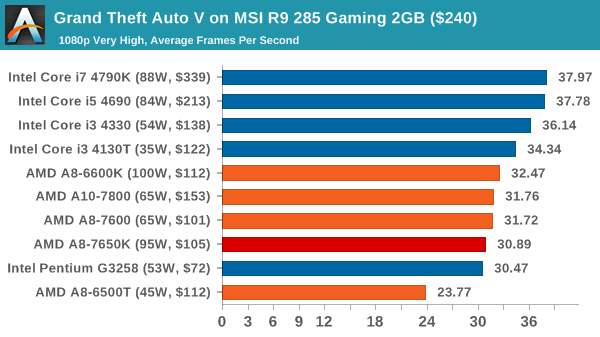
![Grand Theft Auto V on MSI R9 285 Gaming 2GB ($240) [Under 60 FPS]](https://images.anandtech.com/graphs/graph9217/74236.png)

![Grand Theft Auto V on MSI GTX 770 Lightning 2GB ($245) [Under 60 FPS]](https://images.anandtech.com/graphs/graph9217/74246.png)
On GTA, the G3258, the i3-4130T and the A8-7650K perform similarly, within a few frames of each other. Though in both circumstances the $200+ CPUs give the peak performance, up to 20% more than the $100 set.
GRID: Autosport
No graphics tests are complete without some input from Codemasters and the EGO engine, which means for this round of testing we point towards GRID: Autosport, the next iteration in the GRID and racing genre. As with our previous racing testing, each update to the engine aims to add in effects, reflections, detail and realism, with Codemasters making ‘authenticity’ a main focal point for this version.
GRID’s benchmark mode is very flexible, and as a result we created a test race using a shortened version of the Red Bull Ring with twelve cars doing two laps. The car is focus starts last and is quite fast, but usually finishes second or third. For low end graphics we test at 1080p medium settings, whereas mid and high end graphics get the full 1080p maximum. Both the average and minimum frame rates are recorded.
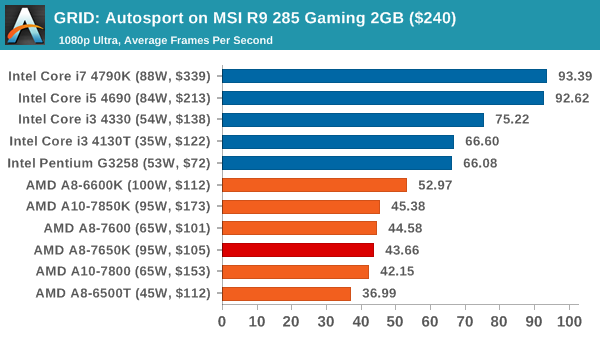
![GRID: Autosport on MSI R9 285 Gaming 2GB ($240) [Minimum FPS]](https://images.anandtech.com/graphs/graph9217/74238.png)

![GRID: Autosport on MSI GTX 770 Lightning 2GB ($245) [Minimum FPS]](https://images.anandtech.com/graphs/graph9217/74248.png)
GRID on an R9 285 seems to love Intel and loves more cores, as shown by the jump from the i3 to the i5. Whereas on a GTX 770, both teams perform similarly, well north of 60 FPS, although the difference lies more in the minimum frame rates.
Middle-Earth: Shadows of Mordor
The final title in our testing is another battle of system performance with the open world action-adventure title, Shadows of Mordor. Produced by Monolith using the LithTech Jupiter EX engine and numerous detail add-ons, SoM goes for detail and complexity to a large extent, despite having to be cut down from the original plans. The main story itself was written by the same writer as Red Dead Redemption, and it received Zero Punctuation’s Game of The Year in 2014.
For testing purposes, SoM gives a dynamic screen resolution setting, allowing us to render at high resolutions that are then scaled down to the monitor. As a result, we get several tests using the in-game benchmark. For low end graphics we examine at 720p with low settings, whereas mid and high end graphics get 1080p Ultra. The top graphics test is also redone at 3840x2160, also with Ultra settings, and we also test two cards at 4K where possible.
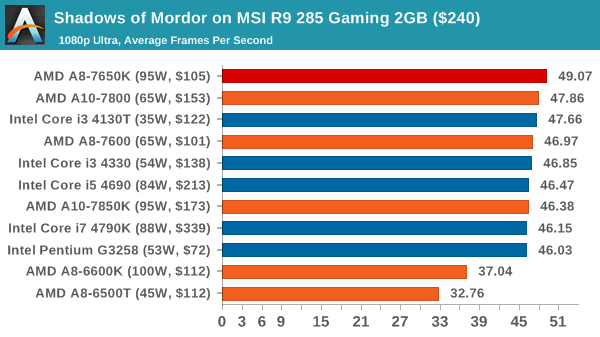
![Shadows of Mordor on MSI R9 285 Gaming 2GB ($240) [Minimum FPS]](https://images.anandtech.com/graphs/graph9217/74240.png)
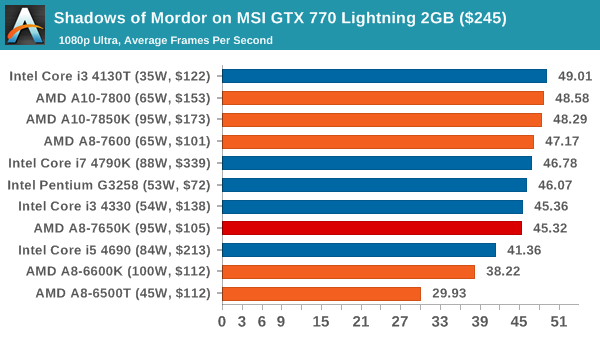
![Shadows of Mordor on MSI GTX 770 Lightning 2GB ($245) [Minimum FPS]](https://images.anandtech.com/graphs/graph9217/74250.png)
Interestingly the APUs so well at 1080p SoM, especially in average frame rates. Unfortunately this does not translate well in minimum frame rates.
Middle-Earth: Shadows of Mordor at 4K
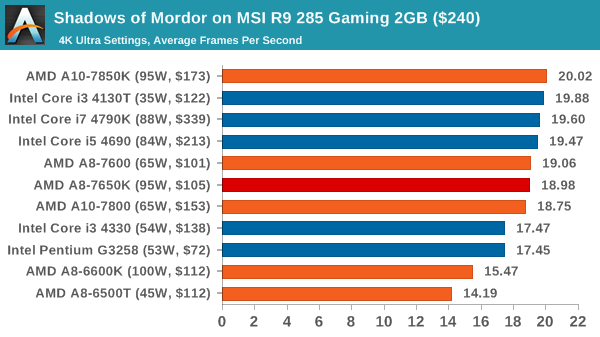
![Shadows of Mordor on MSI R9 285 Gaming 2GB ($240) [Minimum FPS]](https://images.anandtech.com/graphs/graph9217/74240.png)
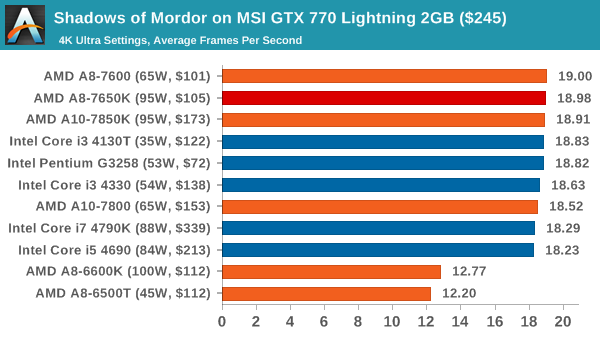
![Shadows of Mordor on MSI GTX 770 Lightning 2GB ($245) [Minimum FPS]](https://images.anandtech.com/graphs/graph9217/74252.png)
At 4K, the older 6000 series APUs seem to be a little behind. With the R9 285 there is also a staggered affect in average FPS performance, although a clear definition in minimum frame rates.















177 Comments
View All Comments
CPUGPUGURU - Tuesday, May 12, 2015 - link
AMD APU is a watt, money, time wasting bottlenecking inferior choice that there is next to no market for, for AMD fusion was and still is a delusion. Intel's world class IPC performance, node process and a dGPU are a MUCH BETTER investment.Intel's APU's performance advantage makes them a wise choice for the Tablet, Convertible, or Ultrabook market, I'm looking forward to a Surface Skylake to go mobile with.
mayankleoboy1 - Tuesday, May 12, 2015 - link
Ian, this is probably the 3rd or 4th testing methodology/benchmark changes that you have seen during AT. My question is:Do you think that Multithreading is *really* more mainstream now? As in, do most general purpose softwares use more than 2 cores?
Ian Cutress - Tuesday, May 12, 2015 - link
The way I like to think about it is that even if software only uses one core, I like to have many on the go at the time. Chrome tabs are a nice example.But multithreading is now being taught in some CS undergraduate classes, meaning that at least it's slowly entering the software ecosystem as default knowledge, rather than as an afterthought. In my opinion, that's always been a big barrier to multithreading (as well as having parallelizable code).
Another thought is consider the software you use. Is it made by a big multinational with a strong software development team? If yes, chances are it is multithreaded. If it uses a big commercial engine, it probably is as well. If it's based on a small software team, then it more likely isn't.
-Ian
V900 - Tuesday, May 12, 2015 - link
Multithreading being taught at CS classes today doesnt matter much.It's not like multithreading is some unknown new technology we can't take advantage of. Dual/quad core processors have been common for over a decade.
OS X have Grand Central Despatch. Windows 7/8 can take advantage of multithreading.
The problem is that it's not all tasks on a computer/in an operating system that does benefit from multithreading.
And that's not going to change. Otherwise we wouldn't see AMD going back to the drawing board and throwing the module-concept in the trash in order to focus on single thread performance like in the Zen CPU.
So unless you know you need it today, multithreading performance is a lousy parameter to choose a CPU from, cause it won't get better in the future.
ppi - Tuesday, May 12, 2015 - link
But now, how many real tasks, where CPU is the real bottleneck ...... and not GPU, storage, internet connection, or gasp ... the user ...
.. and such task is not multithreaded on reasonably written software?
Oxford Guy - Sunday, May 17, 2015 - link
According to rumor you mean.ToTTenTranz - Tuesday, May 12, 2015 - link
Why does Anandtech keep refusing to test lower performance CPUs and APUs with Mantle-enabled games?Those should be a great way to predict the advantages of lower CPU overhead in DX12 and Vulkan.
CPUGPUGURU - Tuesday, May 12, 2015 - link
BECAUSE Mantle is AMD ONLY and DX12/Vulkan will be Intel NVIDIA and AMD, THAT'S WHY.ALSO, Win10 DX12 HAS NOT Been released, drivers are beta at best, SO WHY waste time testing something that's beta and has NOT been released, WHY?
You AMD pumpoholics are brain dead and clueless.
V900 - Tuesday, May 12, 2015 - link
They also seriously think that "Mantle is basically DX12 +/- 10%" which is beyond deluded.Even after AMD knew that Mantle was a one way ticket to nowhere, and pretty much said as much, they still keep bringing it up and treat it as if it's not obsolete. Insanity...
ppi - Tuesday, May 12, 2015 - link
Mantle is currently a great way for to reduce CPU overhead for AMD APUs and CPUs.